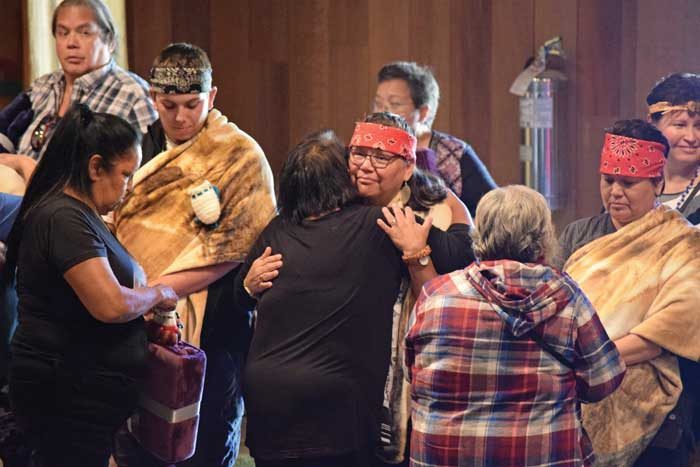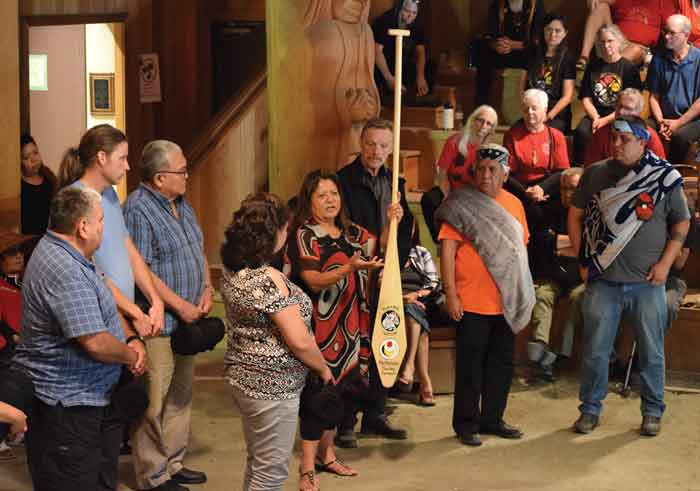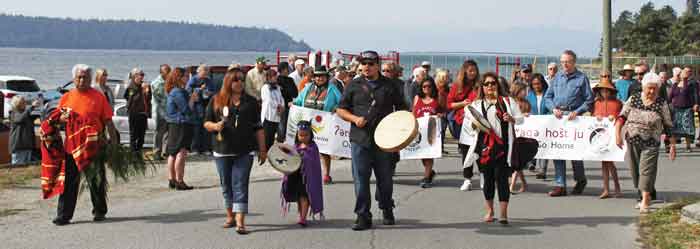Healing together: Spirits of lost children, survivors called home
By Cara McKenna
Photos by Cara McKenna and Todd Peacey
Tla’amin, Homalco and Klahoose called the spirits of their lost children home during a two-day ceremony that involved travelling to the site of a former residential school.
The Calling the Spirits Home Ceremony on Sept. 2 and 3 was organized by Tla’amin’s Hɛhɛwšɩn (the way forward) committee.
The events were held in order to bring home the spirits of residential school survivors, and to put to rest the spirits of those who didn’t make it back to the three communities.
On the first day, dozens of people gathered in the shíshálh Nation longhouse before walking to the site of the former Sechelt Indian Residential School where a memorial now stands.
Elder John Louie (Yahum) brushed the memorial with cedar, asking the spirits of the children from Tla’amin, Homalco and Klahoose who were in residential school to return home.
On day two, a group gathered in Tla’amin to carry spirits from the waterfront to the community cemetery, where Louie led a ceremony to help put them to rest with their ancestors.
Louie spoke about the importance of finally bringing the spirits home.
“For me, the Sechelt people have taken upon themselves, for all these years, to look after the spirits of our people who (went) to these schools,” he said. “The ones who passed on in our communities, they went to their graves without part of their spirit, and the ones still are here, did not have the opportunity to call their spirit because they were not taught in our traditional way.”
Louie himself is a survivor of the Sechelt residential school, and shared that while he was there, he was known not by his name, but as #15.
“We are carrying a lot of things that aren’t ours. I carried the abuse that happened to me in residential school for 50 years. I never spoke about it,” he said. “In some small way I want to see our survivors heal.”
Louie, Cyndi Pallen (čɩnɛ) and Phil Russell (k̓ʷʊnanəm), who organized the events, gifted shíshálh Nation with a paddle featuring the Hɛhɛwšɩn logo.
Along with Tla’amin and shíshálh, representatives from Homalco, Klahoose, Tsleil-Waututh, Squamish and the non-Indigenous community attended the ceremonies.
Several people shared their own stories about attending residential school in Sechelt, including Preston Joseph of Homalco, who now lives in Vancouver.
“I remember some of the experiences at the residential school here in Sechelt and how it was basically like a culture shock… it was a very tough period in that time,” he said. “Like a lot of people who have been in the residential school system, it took me down a pretty bumpy road.”
He said he has been living off the reserve for most of his life, and so he doesn’t have many links to his community or culture, but he often thinks about ways to reconnect.
Pallen said the ceremony was significant because it is part of the process of coming together to bring back what was lost.
She said finding safe places to connect and share experiences with no judgement, while putting teachings and culture into practice, is crucial.
“We’re no longer separated, because that’s how it was when we went to residential school,” she said. “They say that we heal through gatherings like this. We heal by connecting to one another.”






